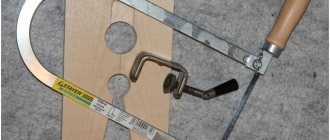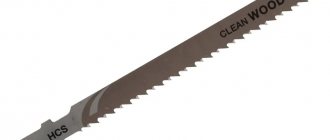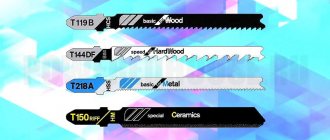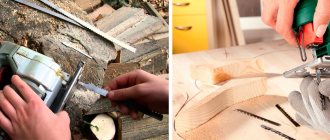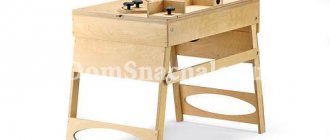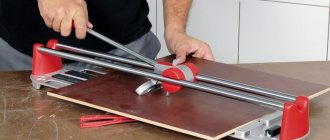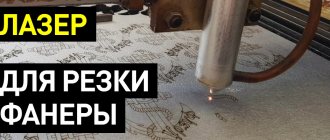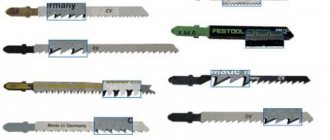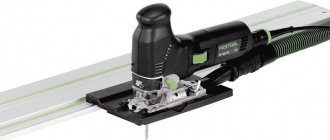Articles
All photos from the article
You can simply go to a store that sells power tools and buy a jigsaw for artistic cutting from plywood, but you can also make such a unit yourself, which will cost much less. In addition, the files of store-bought tools only have a wide blade and it is quite difficult to make openwork patterns with them, where there are sharp bends, rings, curls, etc.
But in this homemade project we will use a thin file used for manual work, so stay with us and you will also be able to see a thematic video in this article.
Homemade electric jigsaw with work table
Choosing a tool
At home, you can cut plywood with both hand and power tools.
Power tools for cutting plywood:
- circular (circular) saw,
- jigsaw
Less commonly, but still can be used for cutting plywood, power tools such as grinders or band saws.
| * Rice. 1.a. Cutting plywood with a circular saw | Rice. 1.b. Cutting plywood with a jigsaw |
* All images are taken from open sources and are provided as examples and illustrations. And are not subject to copyright of our company. If you find your photos here and want to delete them, write to us.
A few words about circular saws
Among the advantages of a circular saw, we note, for example, the ability to cut several sheets of plywood, chipboard or fiberboard (stacked) at once. And also the fact that circular electric saws allow you to cut both thick and thinner sheets of plywood.
The disadvantages of disk tools include the difficulty of obtaining geometrically complex cuts and parts made of plywood. This cutting method is mainly suitable for straight line cutting.
Jigsaw for plywood - ideal for the home craftsman
However, at home, more “piece” or even small shaped work is often in demand. For which a regular manual or electric jigsaw is quite suitable. The latter, of course, significantly speeds up and facilitates the process of cutting plywood sheets.
Hand tool for cutting plywood:
If we talk about hand tools, then for straight and long cuts special hacksaws for plywood and chipboard can be used. For example:
Rice. 2. Hand hacksaw for plywood and chipboard.
Such hacksaws and saws are usually made of spring steel** with the so-called. reverse teeth. And they can be additionally equipped with materials that are harder than the main saw blade.
** Spring steel is a medium- or high-carbon steel, products from which have the ability to easily return to their original shape (despite significant bending and twisting). What happens due to the high yield strength of this type of low-alloy alloys.
If you plan to cut fairly small and geometrically complex parts or shaped workpieces from plywood, then you will, of course, need a jigsaw using a hand tool. Something like this:
Rice. 3.(a). Straight cutting from plywood with a hand jigsaw
Rice. 3.(b). Sawing out shaped parts from plywood with a hand jigsaw
Hand tools or electric?
Let us however note that sawing plywood with hand tools in some cases may not be a very pleasant procedure. The layered structure of plywood with wood fibers in different directions in these layers makes the process quite complex. You won't cut much like that.
Therefore, when choosing how to cut plywood at home, we recommend choosing a modern electric tool. Among which, it seems to us, the most versatile for working with plywood is a jigsaw.
Models
To perform small jobs, it is recommended to purchase a manual jigsaw FIT school 41030. A comfortable wooden handle will allow you to control the process. The price of the model is about 250 rubles. The jigsaw is equipped with a frame and a blade made of durable steel, which guarantees a long period of operation.
The STAYER MASTER manual jigsaw, which costs about 230 rubles, is made of galvanized steel, includes a comfortable wooden handle, and a durable body. The tool is suitable for precise figure cutting.
What jigsaw file should you use to cut plywood?
However, often the most important thing is not what tool you decide to use that you have. And then how competently you select the cutting edge of the working element for your tool.
Choosing a jigsaw file by type of material
When deciding which jigsaw file to choose for plywood, first of all, pay attention to the purpose of the files according to the type of material that you plan to cut.
- It is clear that since plywood is made from wood, the saws used for plywood are mainly the same as for wood .
- For laminated plywood, so that chips do not form on the front side and the cut is neat, many craftsmen also recommend laminate . It has a special “reverse tooth” - directed in the opposite direction compared to other files - which allows you to avoid the formation of chips on the front side of both laminate and plywood, so as not to spoil the appearance. (The marking of such a saw with a reverse tooth may contain the letter “ R ” - reverse).
- Some people prefer to use universal files that work equally well with both wood materials and metal. Sometimes such universal files also include combined ones : the teeth on one half of the saw blade are small, and on the other - large.
By the way, most manufacturers of accessories for power tools adhere to standard markings, which contain information about the purpose of the saw blade depending on the cutting material. In this case, first of all, the grade of steel from which it is made is taken into account. And it is precisely the letter designation of this brand that can be found on the so-called neck of the file (at the border of the shank and the cutting blade itself):
- CV – chrome vanadium steel (for wood and wood boards),
- HCS – high-carbon steel (for wood and wood-based panels, as well as for plastics),
- HSS – high-speed steel (for ferrous and non-ferrous metals),
- HM – hard alloy based on tungsten carbide (for ceramics, fiberglass, etc.)
- BM (or BIM, or Bi-Metal) is a highly elastic combination of HSS and HCS (professional saw blades for wood and metal).
In addition, there may also be marks on the saw blade itself indicating the purpose of the saw. For example:
- Wood – for soft wood and fiber boards,
- Hardwood – for hardwood and laminated panels,
- Inox – for stainless steel,
- Alu – for aluminum,
- Metal – for sheet metal, metal profiles and pipes,
- Fiber&Plaster – for fiberglass,
- Soft-material – for soft materials (rubber, foam, cardboard, etc.),
- Acrylic – for polycarbonate and plexiglass.
Choosing a jigsaw file depending on the planned work:
However, when deciding which saw to cut plywood with, we also recommend answering a number of questions on which the most accurate selection of saw blade depends:
| Question | Recommendations for selecting jigsaw files : |
| Thickness of your existing plywood | For thick boards, plywood or chipboard, you will accordingly need a longer, stronger, bend-resistant (usually thicker) jigsaw blade. In some cases, it is also recommended to use wider saw blades. Because The wider the saw blade, the more stable it is. |
| Cutting geometry : do you plan to make a straight or figured (curvilinear) cut? | For straight cuts Most often, wide files with a medium tooth are recommended. Or files with alternating small and large teeth (making the cutting edge look like shark teeth). Note that, for example, not only the speed, but also the quality of the cut depends on the width and thickness of the saw blade. For curved cuts (if you are cutting complex parts with curved lines from plywood), it is recommended to use a file with finer teeth and a narrow saw blade (so that the file does not get pinched when the jigsaw turns). |
| finishing and rough cutting of plywood? | The larger the saw teeth, the faster the cut is made. But the cut itself will be rough: not too neat, with chips. And the smaller the saw teeth (and, including the size of their setting), the more accurate and high-quality (without chips, etc.) you will be able to cut plywood. However, the speed will be noticeably lower. also use a laminate saw to make a clean cut of plywood without chipping |
In addition, when choosing a file, do not forget to pay attention to the type of attachment to the tool: T-shaped, V-shaped, etc. It is important that the file is “compatible” with your jigsaw and holds firmly in the tool during operation.
Rating of jigsaws
The models of these instruments are very diverse. You can buy a budget option, or you can buy a high-end professional device.
Well-known global manufacturers offer a wide range of tools that differ in reliability, properties and functionality.
The following are the ten best models:
- Bosch GST 65B - characterized by low vibration and reliable sole attachment. Has forced airflow.
- Bosch PST 10.8 LI - stands out among analogues in that it can run on battery power and also has LED backlighting.
- Makita 4329 is a device with low vibration characteristics, has three pendulum modes, and is equipped with a rubberized handle.
- AEG BST 18X - battery operation is the most important difference from other models; this jigsaw is also equipped with a face protection screen, an electronic brake, a cast aluminum sole and has extensive functionality.
- DeWALT DW 349 is a powerful device with a handle with easy platform adjustment. In addition, it easily switches speeds, has LED backlighting and airflow.
- DeWALT 331K - this model is especially reliable, as it is equipped with a closed type engine. It has many settings and adjustment of the tilt of the canvas. Its soles are equipped with pads made of soft material.
- Ryobi CJS 180L - the device has face protection and a laser pointer.
- Interskol MP-100E is a domestic model, its advantage is its low cost. It is also equipped with a hinged lid, which makes it easy to clean the instrument.
- Bosch GST 14.4 V-LI Professional - can be powered by battery, equipped with lighting and airflow.
- Makita JV100DWE is a compact jigsaw with adjustable blade stroke. More often it is purchased for use at home.
An electric jigsaw is a compact and inexpensive device that is an assistant in many types of work.
This device must be used carefully, in accordance with all safety rules, this is the only way to eliminate the risk of unpleasant situations.
How to cut plywood without chipping?
And finally, let’s try to briefly answer the question: “How to cut plywood without chipping with a jigsaw?”
Here you should pay attention to a few fairly simple tips that will help you get an even and smooth cut:
- It is not recommended to saw plywood on uneven surfaces or on weight, without stable fastening of the plywood sheet - to prevent movement and displacement both up and down and in the lateral directions. Ideally, use a specialized workbench. If you do not have this opportunity, then consider options for placing and fastening sheets of plywood using several clamps or other available means. Otherwise, you are almost guaranteed to have distorted cuts and an increased likelihood of breaking the saw blade.
- If your jigsaw has a beat mode, we recommend turning it off. The cutting blade should move smoothly, without jerking.
- Try to keep the cutting blade at a right angle to the plane of the plywood sheet throughout the entire cut.
- Do not press on the jigsaw to speed up the process of cutting plywood - a high-speed tool at a low feed speed of the cutting edge will do the job just fine. And excessive pressure can lead to breakage of the saw blade and the appearance of unwanted chips or other disturbances in the appearance of the cut.
- If you are cutting laminated plywood, then from the front side of the plywood you can first go along the intended line of the future cut with the blade of a construction knife. This will additionally help avoid unwanted damage to the laminating layer when cutting.
- To avoid chipping when cutting non-laminated plywood, some craftsmen suggest pre-treating the future cut site (along its entire length) with PVA glue. Or protect the cut line with electrical tape or masking tape. (In the case of PVA glue, cutting should begin only after it has completely dried).
Additional jigsaw functions
Jigsaws are equipped with additional functions; new items among these tools have the largest number of them.
Mainly:
- Forced airflow;
- Smooth start;
- Laser type pointer;
- Types of cartridges;
- Backlight;
- Power stabilization under increased loads.
Features of work
A jigsaw is a tool that allows you to cut various elements from plywood and create ornaments. The thin serrated blade makes various cuts, lines and allows you to create wood decorations. A jigsaw is also used in construction, but in this article we will focus specifically on cutting out decorative elements. Cutting with a jigsaw has a number of features. There are many variations of this tool. The two main types are manual and electric jigsaws. The manual jigsaw was originally invented. This design consists of an arc and a blade. The blade is secured with clamps that allow you to change the tension. The frame includes a handle.
The clamps can be positioned to rotate. This allows you to change the plane and create complex carving elements. The file of a manual jigsaw and its entire structure are subject to wear, so the file has to be changed frequently. Craftsmen who work with hand tools have many spare saw blades for replacement. A jigsaw is a tool that runs on mains power. The body contains mechanisms, there is a handle on the body, the sawing element is located in the front part at the bottom of the body. Sometimes there is a foot that helps you cut smoother. There are models with attachments used to facilitate sawing and edge alignment.
When working with a jigsaw, you should familiarize yourself with the parameters that are specified in the instructions in order to know exactly how to use the tool for cutting out patterns. This tool differs from a hand jigsaw in the way the file is attached, its thickness and weight. A jigsaw has more weight and less accuracy, but it has significantly higher productivity.
Carving techniques for beginners
Organization of the workplace is important. The master must work while sitting in a comfortable position, without bending or reaching with his hands to the place of work. For small parts, a sawing table is used.
They are on sale. But to gain first experience, it is better to cut it out with your own hands from a piece of thick plywood or board according to the following drawings:
The table is attached to a large work table with a clamp or self-tapping screws.
In some cases, it is more convenient to clamp the workpiece vertically with a clamp, then you will have to cut not from top to bottom, but horizontally, which is more convenient.
